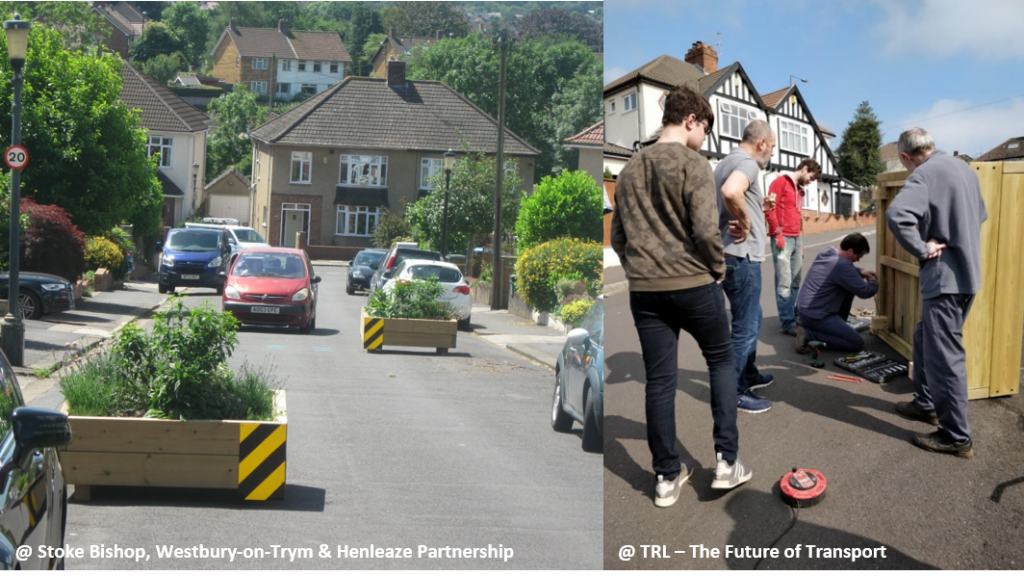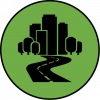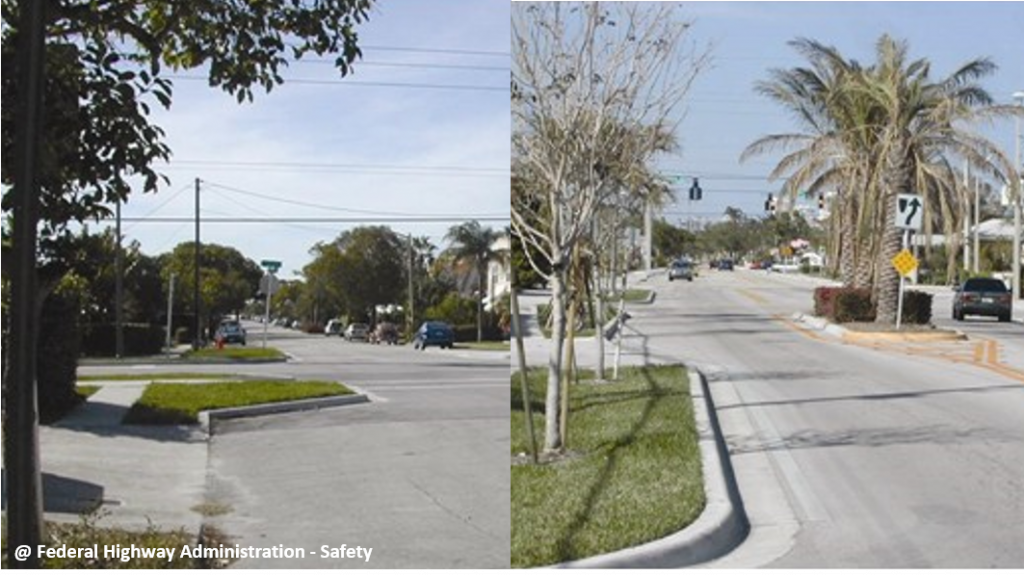
1. Presentation
This traffic calming measure concerns the implementation of physical elements to reduce speed and volume of motorized vehicles, in order to ensure compatible traffic conditions between the different transport modes. These measures improve safety and comfort for non-motorized and more vulnerable users (pedestrians and cyclists).
2. Objectives
- Reducing the speed of motorized vehicles in order to allow the shared use of roadways by different transport modes.
- Improving safety for cyclists.
3. Measure Importance
Several studies have shown that motorized traffic is the biggest barrier to cycling mobility. Traffic calming and speed reduction are essential to promote bicycle use, as they decrease the need to segregate the bicycle, fostering equality between motorized and non-motorized modes of transport in the same physical context.
1. Good Practices
– This measure is key for car traffic calming. Traffic calming if only through legal speed limits usually has reduced effects, unless it is accompanied by heavy inspection or physical measures like those presented here.
– It is essential to choose the measure or set of measures most appropriate to the local context and objectives. For instance, the use of vertical deflections (speed bumps) on roadways to be shared by bicycle and car should be used with caution, since the bumps are very damaging to cyclists.
– These measures become more effective if they are used frequently on the same stretch of road rather than sporadically (the use of speed bumps on a crosswalk only slows down the speed for the crosswalk, but is not as effective at slowing down the whole street, limiting its effect to a few meters before and after the bump).
– Work with experts with up-to-date knowledge of the measures and designs in use.
– Use different types of traffic calming measures and different actions within each measurement (See Roadway narrowing and Limited speed zones).
– Design the intervention taking into account that streets are used for various purposes, namely, travelling, sightseeing, socializing, trading and living, in the sense that the streets are the entrance spaces for the dwellings. As such, interventions should be designed to improve the aesthetics and comfort of pedestrians and cyclists, besides reducing the speed of motor vehicles.
– STOP signs should not be used as a means of traffic calming.
– New interventions should receive extra signage to alert the new conditions. After a few years, the extra signals can be removed.
– Monitor citizens’ adaptation to changes and reformulate measures to respond to users’ needs, without compromising sustainable ideals (See Management, monitoring and maintenance).
– Explain the principles behind the measures taken so that their need and functioning are clear (See Information).
2. Actions
 | Chicanes A chicane is a series of alternating curves or lane shifts, which causes a marked deflection in the travel path, resulting in speed reduction. They can be materialized in a variety of ways, from the simple introduction of obstacles to circumvent, to the construction of a sidewalk or landscape buffers, or even by the definition of parking spaces. Advantages: They have a vast domain of application and various forms. Disadvantages: In places with low traffic they can be ineffective because drivers use the other side of the road. |
 | Speed hump Speed humps are a rounded raised mound of pavement placed across a street, in order to produce physical and visual impact on the driver. The sinusoidal humps are the most inconvenient for cars, but more comfortable for cyclists, as they ensure a smoother initial climb. |
 | Raised crosswalk A flat-topped speed hump, trapezoid-shaped, that extends from curb to curb, allowing pedestrians and cyclists to cross. This type of measure must have a floor treatment of the flat section in order to improve its appearance and to signal its presence to drivers. |
 | Raised intersections A flat area covering the intersection of two or more streets, generally raised to an intermediate or sidewalk level with ramps on all approaches. Advantages: Reduce vehicle-pedestrian-cyclist conflicts. |
 | Shared streets (See Limited car access areas, specifically the action “shared streets”). |
 | Bottlenecks / Roadway reduction Sporadic road narrowing by means of extension of sidewalks, construction of green spaces lateral to the carriageway, construction of bicycle paths, etc. Advantages: It is a key measure to promote traffic calming and to ensure space for soft modes. |
 | Intersections narrowing Narrowing of a street at an intersection to reduce the width of the travelled way by widening a sidewalk. They increase visibility levels and reduce cross-over length for pedestrians. They condition drivers’ behaviour, formalizing parking spaces and reducing the turning radius. Advantages: Reduces pedestrians risk exposure. Disadvantages: Not suitable for places where there are bicycle paths, requiring their interruption. |

Residents of Hildson Road (U.K.) created paintings on the road and set up flower beds in the middle of the street to create chicanes and slow down traffic.
Learn more: trl.co.uk/sites/default/files/Community%20Corners%20Final%20Report.pdf
1. Impacts
 | Mobility system efficiency By creating obstacles for the car, the measure tends to discourage its use and promote alternative modes of transport, reducing congestion. However, by reducing traffic speed, it can also generate some congestion points. |
 | Livable streets The interventions require the redesign of public space in order to reduce conflicts between vehicles, pedestrians and cyclists. Facilitating the movement of active modes and the sharing of space between different users promotes the humanization of the city. |
 | Protection of the environment Studies indicate that traffic calming measures favour the modal shift from the car to the bicycle, which reduces air and noise pollution. |
 | Inclusion, equity and accessibility Traffic calming measures ensure the improvement of accessibility and travel options for users of alternative modes of transport. |
 | Safety and comfort By reducing car speed and increasing the visibility of pedestrians and cyclists, the streets become safer and more comfortable for all. |
 | Economic value The measure promotes a more attractive access to local shops and services by improving safety and environmental quality. However, traffic calmed areas can also be less attractive for car users, reducing accessibility for visiting traffic. |
 | Awareness and acceptability The provision of traffic calming measures promotes greater use of the bicycle, which may influence more sceptical groups to use the bicycle more often. |
Legend:
| Very positive | Positive | Neutral | Negative | Very negative |
2. Barriers
 | Legal Countries where there is no legal framework or guidance on traffic calming may face legal barriers. |
 | Finance Costs change depending on the degree of intervention. The more complex the materials used and the redesign of the urban space, the higher the cost. |
 | Governance Traffic calming can usually be implemented by a single public department. |
 | Political acceptability Measures focused on reducing the car competiveness often have little priority within policymaking. |
 | Public acceptability The citizens who live or often use the treated area may raise some opposition. Aesthetics and the precise location of calming measures are often important influences on acceptance. Some surveys show that the majority of those living in traffic calmed areas are satisfied with the measure. |
 | Technical feasibility Some traffic calming measures require specific technical know-how. |
Legend:
| No barrier | Minimum barrier | Moderate barrier | Significant barrier |
3. Budget
| Area | Measure | Unit | Cost | Implementation year |
| Seixal, Setúbal (Portugal) | Acquisition of speed control traffic lights | 2 | 14 225,00 € | 2018 |
| Valongo, Porto Metropolitan Area (Portugal) | Acquisition of speed humps and parking deterrents | 120 non-slip rubber speed humps, 480 screws and 480 plastic bushes for fixing the humps; 55 flexile traffic post | 5 000,00 € | 2019 |
| The Netherlands and Germany
|
Raised pedestrian crosswalks | 1 m2 | 5,00£ – 20,00£ | Mid-1980s |
| Narrowing of entrances and intersections | ||||
| Intersections treatment | ||||
| Vegetation planting |
Case study 1: Clematis street, West Palm Beach (U.S.A.)

In West Palm Beach city, traffic calming measures are typically implemented when a street is being built or refurbished (for infrastructure or other reasons). In the case of Clematis street, the area was degraded and 80% of the buildings were empty. The implemented plan included: elimination of one road lane (from 3 to 2); bottlenecks; one raised intersection; chicanes, etc. Since then, the street has become one of the main centres of activity in the city, with various businesses and leading to the increase of property values.
Impact:
 | Mobility system efficiency No data. |
 | Livable streets The street has become one of the main centres of activity in the city. |
 | Protection of the environment No data. |
 | Inclusion, equity and accessibility The street is considered safe, so that families with young children stroll and play comfortably. |
 | Safety and comfort The measure aims to directly promote safety and comfort for all street users, even if the case study did not evaluate the impacts at this level. |
 | Economic value The intervention attracted more business and has increased 10 times property values. |
 | Awareness and acceptability No data. |
Legend:
| Very positive | Positive | Neutral | Negative | Very negative |
IMTT (2011). Princípios de Planeamento e Desenho. Colecção de Brochuras Técnicas / Temáticas Rede Ciclável. Accessed 2 July 2019. Available at: http://www.imt-ip.pt/sites/IMTT/Portugues/Planeamento/DocumentosdeReferencia/PacotedaMobilidade/Documents/Pacote%20da%20Mobilidade/Rede%20Cicl%C3%A1vel_Princ%C3%ADpios%20de%20Planeamento%20e%20Desenho_Mar%C3%A7o%202011.pdf
InIR. Instituto de Infraestruturas Rodoviárias. (2011). Medidas de Acalmia de Tráfego (Vol.1) – Medidas Individuais Aplicadas em Atravessamentos de Localidades, Disposições Normativas. Accessed 23July 2019. Available at: http://www.imt-ip.pt/sites/IMTT/Portugues/InfraestruturasRodoviarias/InovacaoNormalizacao/Divulgao%20Tcnica/MedidasAcalmiaTrafegoVol1.pdf
ITE/FHWA. (1999). Traffic Calming: State of the Practice. Accessed 3 July 2019. Available at: http://www.industrializedcyclist.com/trafficcalming.pdf
Juhász, M., & Koren, C. (2016). Getting an insight into the effects of traffic calming measures on road safety. Transportation Research Procedia, 14, 3811–3820. Accessed 6 February 2019. Available at: https://doi.org/10.1016/j.trpro.2016.05.466
KonSULT. Knowledgebase on Sustainable Urban Land use and Transport. (2014). Traffic Calming Measures. Accessed 6 February 2019. Available at: http://www.konsult.leeds.ac.uk/pg/13/
Mertens, L. et al., 2017. Built environmental correlates of cycling for transport across Europe. Health & Place, pp. 35-42.
NACTO. National Association of City Transportation Officials. (2013). Urban Street Design Guide. Accessed 6 February 2019. Available at: https://nacto.org/publication/urban-street-design-guide/
NEITE. New England Institute of Transportation Engineers. (2016). Traffic Calming. Accessed 6 February 2019. Available at: http://neite.org/wp-content/uploads/2016/10/NEITE-Final-Traffic-Calming-Guidelines-6-30-2016.pdf
Global Road Safety Partnership. (2008). Speed management: a road safety manual for decision-makers and practitioners. Accessed 3 July 2019. Available at:https://www.who.int/roadsafety/projects/manuals/speed_manual/en/
Pereira, P. C. (2014). Devolver as Cidades às Pessoas. Accessed 6 February 2019. Available at: http://transportesemrevista.com/Default.aspx?tabid=210&language=pt-PT&id=40088
Pereira, J. (2013). Medidas de acalmia de tráfego em áreas urbanas consolidadas: Um caso no concelho do Seixal. (Tese de Mestrado) Faculdade de Ciências Sociais e Humanas da Universidade Nova de Lisboa e Universidade Atlântica, Lisboa. Accessed 6 July 2019. Available at:https://run.unl.pt/bitstream/10362/12093/1/Medidas%20de%20acalmia%20de%20tr%C3%A0fego%20em%20%C3%A1reas%20urbanas%20consolidadas_.pdf
PPS. Project for Public Spaces. (2008). Traffic calming 101. Accessed 6 February 2019. Available at:www.pps.org/article/livememtraffic.
Seco, Á., Ribeiro, A., Macedo, J., & Silva, A. B. (2008). Acalmia de tráfego – Manual do Planeamento de Acessibilidades e Transportes. Accessed 3 July 2019. Available at:http://www.estgv.ipv.pt/PaginasPessoais/vasconcelos/Documentos/ManualdeAcessibilidades/ManuaisCCDRNmiolo_AF/10Acalmia_AF.pdf
Stillings, T., Lockwood, I. (2001). West Palm Beach Traffic Calming: The Second Generation. Accessed 8 July 2019. Available at: http://onlinepubs.trb.org/onlinepubs/circulars/ec019/Ec019_i5.pdf
Vieira, D. (2008). Medidas de Acalmia de Tráfego em Zonas Residenciais. (Tese de Mestrado Integrado). Faculdade de Engenharia da Universidade do Porto, Porto.
VTPI. Victoria Transport Policy Institute (2018). Traffic Calming. Online Transportation Demand Management (TDM) Encyclopedia. Accessed 2 July 2019. Available at: www.vtpi.org/tdm/tdm4.htm
